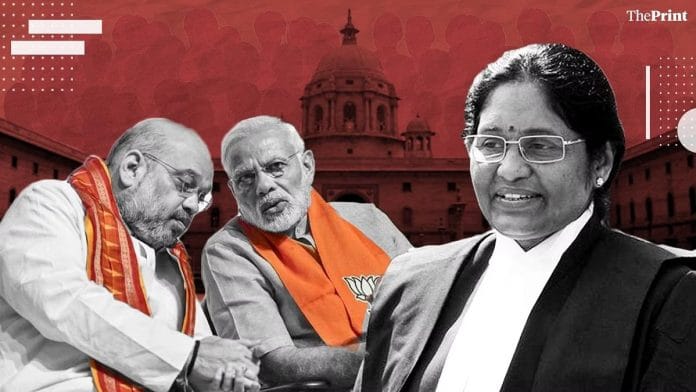New Delhi: Even as the Supreme Court allowed sub-classification within Scheduled Castes and Scheduled Tribes for the purposes of reservation for the more marginalised among these categories, the Modi government is yet to accept the recommendations of the Rohini Commission set up to examine sub-categorisation of Other Backward Classes (OBC), ThePrint has learnt.
Constituted in October 2017 to examine sub-categorisation of OBCs and ensure equitable distribution of reservation benefits, Rohini Commission submitted its report to President Droupadi Murmu on 31 July, 2023. The report has not been made public yet.
Government sources told ThePrint that the Ministry of Social Justice and Empowerment, which deals with policy issues related to welfare of OBCs, is yet to receive the report from the Rashtrapati Bhawan.
“The ministry is yet to initiate deliberations on the recommendations made by the commission. The President has to forward the report to the ministry only after which deliberations will begin on the recommendations made in the report,” said one source.
The source added that the Rohini Commission report, like the Mandal Commission report, once accepted by the government, should ideally be tabled in Parliament.
Since it was set up, the term of the four-member commission headed by Justice G. Rohini, a retired chief justice of the Delhi High Court, was extended 13 times till it eventually submitted its report.
Caste politics is known to play a dominant role in deciding poll outcomes in India, be it parliamentary or assembly elections.
“The government did not want to open a Pandora’s box in the middle of one or the other assembly elections and the Lok Sabha elections,” said a second source in the government.
A study conducted by the Rohini Commission while drafting its report found that just about 40 of the approximately 5,000-6,000 sub-categories/groups among the OBCs — less than 1 percent of the total OBC population — had cornered 50 percent of reservation benefits in central government jobs and educational institutions.
On Thursday, a seven-judge Constitution bench presided by the Chief Justice of India in its verdict upheld the power of states to sub-classify reserved category groups. During the hearings, the Modi government backed sub-categorisation among SCs and STs on the grounds that it “furthers the actual purpose” behind introduction of quotas.
Also Read: Rohini Commission report ‘addresses Hindu-Muslim anomaly’ in OBC quota for occupational groups
Sub-categorisation of OBCs: A political hot potato
Sub-categorisation of OBCs, which comprise thousands of sub-categories, has been a long-standing demand among some disadvantaged sections to ensure better distribution of the benefits of reservation.
The issue, along with the demand for a nationwide caste census, is widely viewed as a political hot potato, with the Opposition and the Congress in particular pressing for the findings of the Rohini Commission to be made public and for the government to conduct a caste-wise headcount of Indian citizens. Further, the issue also assumes significance ahead of assembly polls in Maharashtra, Haryana and Jharkhand due later this year.
However, with the Rohini Commission report yet to be made public, it is unclear on what basis reservation will be accorded to different sub-groups within the OBCs.
A member of the commission had previously told ThePrint that instead of social hierarchy, the panel looked at the capability of the sub-categories to avail government benefits.
The commission, the member had said, looked at data to assess the extent to which each group availed quotas. Based on that criteria, it has recommended further distribution of the 27 percent quota for OBCs.
The second government source said that this will ensure that those within OBC sub-categories, who were not getting any benefits so far, could now stand to gain.
The First Backward Class Commission, set up in 1953 and chaired by Kaka Kalelkar had proposed sub-categorisation of OBCs into two groups: backward and extremely backward.
The idea of sub-categorisation was also proposed in a dissenting note by L.R. Naik, a member of the Second Backward Class Commission headed by B.P. Mandal. Naik, too, proposed a division of OBCs into two groups to protect the interests of the weakest within the community: intermediate backward classes and depressed backward classes.
(Edited by Amrtansh Arora)
Also Read: No more Hindu-Muslim anomaly, Rohini panel seeks parity for all religions’ OBCs in central list






